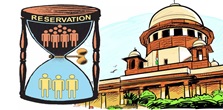15 December, 2025
Hearing in Supreme Court on demand to implement Creamy Layer in SC/ST reservation
Thu 14 Aug, 2025
Context:
- On 13 August 2025, the Supreme Court decided to hear a petition filed by Ramshankar Prajapati, demanding the implementation of the creamy layer system in SC/ST reservations, similar to OBCs.
Key Points:
- The petition argues that the current reservation policy benefits the affluent and influential sections within SC/ST communities more, while the most deprived remain trapped in the cycle of poverty.
- The petitioner has demanded a two-tier reservation system based on economic criteria, giving priority to the economically weaker sections.
- A bench of Justices Surya Kant and Joymalya Bagchi issued a notice to the central government and scheduled the hearing for 10 October 2025.
- The petition cited the Supreme Court’s August 2024 judgment (Punjab vs. Davinder Singh), where the Court had suggested developing a policy to identify the creamy layer within SC/ST and exclude them from reservation benefits.
Supreme Court’s August 2024 Judgment:
- The Supreme Court’s decision on 1 August 2024 (State of Punjab and Others vs. Davinder Singh and Others) is a historic verdict on the issue of sub-classification within Scheduled Castes (SC) and Scheduled Tribes (ST) reservations.
- This decision was given by a seven-judge Constitution Bench with a 6:1 majority.
Key points of the judgment:
Constitutional support for sub-classification:
- The Supreme Court held that sub-classification among SC/ST for equal distribution of reservation benefits is valid. That is, now state governments can create sub-categories within Scheduled Castes and Scheduled Tribes so that reservation benefits actually reach the most backward and needy groups.
Recommendation for the creamy layer concept:
- The judgment also stated that the path is open for implementing the creamy layer provision for SC/ST classes. However, this creamy layer should be different from that of OBCs and adapted to special circumstances.
- Those considered part of the creamy layer will not get the benefit of reservation so that the benefits reach truly needy parents and individuals.
Powers to state governments:
- States have been given the power to determine their own criteria for SC/ST sub-classification and creamy layer. The objective is to fulfill the real aim of reservation — social justice and benefits to the deprived sections.
Majority vs. Minority:
- Six judges recognized sub-classification, while one opposed it. The dissent was based on the concern that broad social reservation could be reduced to purely economic and class-based criteria.
Creamy Layer
A socio-economic concept created to identify relatively affluent and educated sections within the backward classes (OBC), who are excluded from reservation benefits.
- Its aim is to ensure that only those who are truly socially and educationally backward get the benefit of reservation.
Origin of the creamy layer concept:
- Source: The idea came from the recommendations of the Mandal Commission in 1979
- Legal basis: In the 1992 Indra Sawhney vs. Union of India judgment, the Supreme Court made provisions for its implementation
- • The Court said that it is necessary to exclude the “affluent” class from OBC reservations
Scope of creamy layer implementation:
- Applied only to Other Backward Classes (OBC)
- Not applied to SC/ST classes (though debated from time to time)
Creamy layer income limit:
- Initially ₹1 lakh (1993)
- Revised several times —
-
- 2004: ₹2.5 lakh
- 2008: ₹4.5 lakh
- 2013: ₹6 lakh
- 2017: ₹8 lakh (current limit)
Currently, if an OBC family’s annual income exceeds ₹8 lakh, it falls under the creamy layer and is not eligible for reservation.
Criteria for determining creamy layer:
- Economic: Annual family income limit (₹8 lakh)
- Social/Occupational:
- Parents in high-ranking positions (IAS, IPS, IFS, All India Services)
- High-grade officers in central/state governments
- Persons at top-level posts in the public sector
- Armed forces officers of Colonel rank or above
-
- Agricultural income is excluded from this calculation
Important judicial references:
- Indra Sawhney Case (1992): Recognition of the creamy layer concept
- Ashoka Kumar Thakur Case (2008): Application of creamy layer in OBC reservation in educational institutions
Scheduled Castes (SC) and Scheduled Tribes (ST)
- Scheduled Castes (SC): Castes listed in the Indian Constitution that historically faced untouchability, social discrimination, and economic backwardness.
- Scheduled Tribes (ST): Tribal communities primarily living in remote and forest areas, with distinct culture, language, traditions, and lifestyles, historically isolated from the mainstream.
Constitutional provisions:
- Article 341: Power to determine the list of Scheduled Castes.
- Article 342: Power to determine the list of Scheduled Tribes.
- The President issues notifications to determine SC/ST lists, and Parliament holds the power to amend them.
Reservation and special rights:
- • Reservation in education, employment, and political representation: For SC — 15%, for ST — 7.5% (in central services and education)
Constitutional safeguards:
- Articles 15(4), 16(4): Special provisions for social and educational advancement
- Article 46: Promotion of educational and economic interests of SCs, STs, and other weaker sections
Major laws related to SC/ST:
- SC and ST (Prevention of Atrocities) Act, 1989 — Aims to prevent discrimination, exploitation, and violence against SC/ST communities, with strict penalties and provision for special courts
- Constitution (Scheduled Castes) Order, 1950
- Constitution (Scheduled Tribes) Order, 1950
Population and distribution in India (Census 2011):
- SC population: ~201.4 million (~16.6% of total population)
- ST population: ~104.5 million (~8.6% of total population)
- Highest SC percentage: Punjab (~31.9%)
- Highest ST percentage: Mizoram (~94.4%)
Other Backward Classes (OBC):
- Castes and communities that are socially and educationally backward but not included in the Scheduled Castes (SC) and Scheduled Tribes (ST) categories.
- OBCs are given reservation benefits in education, government jobs, and other areas to improve their socio-economic status.
Constitutional and legal basis:
- Articles 15(4) and 16(4): Power to make special provisions for socially and educationally backward classes
- Mandal Commission (1979): Set up under B.P. Mandal, recommended in 1980 to provide 27% reservation for OBCs
- Indra Sawhney vs. Union of India (1992): Upheld 27% OBC reservation but directed exclusion of the “creamy layer”
Types of OBC:
- Central List OBC: Recognized for central government jobs and educational institutions
- State List OBC: Recognized only for state government jobs and institutions
Reservation system (central level): 27% for OBC (excluding creamy layer)
Reservation system (state level): Percentage varies by state; some states have sub-categorized OBC (e.g., OBC-A, OBC-B)
Reservation and Related Constitutional Articles
| Article of the Constitution | Subject / Provision |
| Article 14 | Right to equality and equal protection before the law |
| Article 15(3) | Power of the State to make special provisions for women and children |
| Article 15(4) | Special provisions for socially and educationally backward classes (SC/ST/OBC) |
| Article 15(5) | Reservation for socially backward classes including in private educational institutions |
| Article 15(6)(a) | Special provisions for Economically Weaker Sections (EWS) |
| Article 16(4) | Reservation in government appointments for backward classes |
| Article 16(4A) | Reservation in promotions for Scheduled Castes and Scheduled Tribes |
| Article 16(6) | Reservation in government appointments for EWS |
| Article 330 | Reservation of seats in Parliament (Lok Sabha) for SC/ST |
| Article 332 | Reservation of seats in State Legislative Assemblies for SC/ST |
| Article 335 | Consideration of claims of SC/ST along with efficiency of administration |
| Article 338 | Establishment and powers of the National Commission for Scheduled Castes |
| Article 338A | Establishment and powers of the National Commission for Scheduled Tribes |
| Article 338B | Establishment and powers of the National Commission for Backward Classes (NCBC) |
| Article 243D | Reservation of seats for SC/ST in Panchayats |
| Article 243T | Reservation of seats for SC/ST in Municipalities |


















